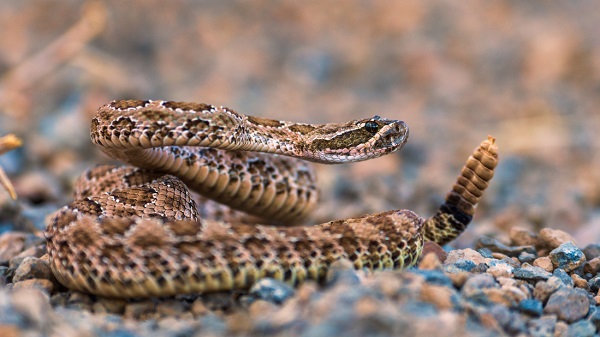Rattlesnakes are traced all over the United States. They pose a threat to canine life. If you maintain precaution and seek concrete measures, they will help you prevent a snake attack. Rattlesnakes prefer to stay in the bush or rocks.
So, parks and mountains are their favorite grounds and places that happen to be dog owners’ walking and hiking places with their dogs. So, an encounter is a common occurrence. The result can be fatal too. Near about 3 million pets are bitten by snakes every year.
Types of rattlesnakes include:
- Western Diamondback
- Mojave Rattlesnake
- Panamint / Speckled Rattlesnake
- Western Rattlesnake
- Red Diamond Rattlesnake
- Sidewinder
Rattlesnake vaccine
Rattlesnake vaccines for dogs are readily available. These vaccines are developed by an organization named Red Rock Biology. The anti-venom is made from snake venom. Hence, it reduces the effect for a prolonged time but can’t eliminate the effects. So, vet care is mandatory.
The price of each anti-venom vial varies. It can range between five hundred to a thousand dollars according to the place. The vaccine is twenty-five dollars. So, vaccination is cost-effective.
Six feet leash for the walk
If a snake is present around you or your dog, the hissing sound of a rattlesnake will be apparent and most certainly heard. Watch out for it. Keep your six feet leash. According to many vets, a snake bite happens when the dog is without a leash. A retractable leash is also not a good cause. It’s out of the reach of the pet owner to control any worst situation from occurring.
Keep away from bush and grasses as much as possible
In a time of hiking or walking in rural areas, it’s better to avoid the narrow trail and bushes. Because these are the favorite hideouts of rattle. While walking on a wide trail, you can see the snake sunbathing without knowing your presence with your dog, which helps you avoid and quietly leave that area.
Guard your yard from snake
The fence may provide a secured haven for your dog. But without any fortification, it’s can’t prevent the snake from entering the yard. Snake enters from below the fence. If you are cementing the ground, it will be good but not enjoyable for your dog, and it costs too. So, an eighteen-inch-thick plastic can cover the below portion, including the gate area.
Symptom of snake bite
Understanding the snake bite symptom can reduce the effect of venom by reaching the vet for treatment. There are some immediate effects, and some are evident after a few hours.
Immediate symptom
- Wound, sometimes without any bleeding
- Swelling in the area
- Excessive pain
- Agitation, puff, and salivation
Symptom after an hour
- Passivity, debility, fall in
- Shaking of muscle
- Diarrhea
- Confiscation
- Sallow respiration
Majorly dog bites by snakes happen in the head or leg area. If it gets bitten in its leg, the spreading process becomes slow. Swelling obstructs air passage. The dog may cry when the affected area is touched. As rattlesnake venom is neurotoxic, it affects nerves that resulting in the inability to move about.
It can even lead to paralysis. Don’t use a compression bandage to the area if you are not smart with the process. Inexperience can damage the area. It’s better to wrap the area with ice in a towel. It reduces swelling and spreading.
What to do if the dog gets bitten?
Carry your dog to the car if possible. If it’s impossible to carry, walk him to the car. You can decrease spreading by limiting the activity. Get your veterinarian as soon as possible in an emergency. The early the treatment starts; the chance of survival increases.

 DogExpress
DogExpress


















 in Chandigarh, India.
in Chandigarh, India. 
